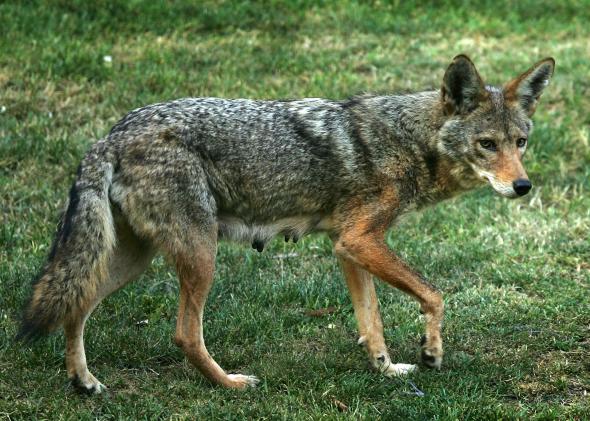
Photo by John Moore/Getty Images
Humans are not newcomers when it comes to messing around with nature.
While we haven't created Frankenstein's monster yet, what we do messes
with the natural world. One recent example is the creation of the
coywolf—a hybrid of the coyote and the wolf that is also known as the
Eastern coyote.
These animals have a completely new genetic make up: Their genes are
about 1/4 wolf DNA and 2/3 coyote DNA, the rest is from domesticated
dogs. They were created when previously separate wolf and coyote
populations merged in the land north of the Great Lakes.
Here's the coyote, which traditionally maxes out at 75 pounds and has pointier features, and readily populates cities:

Photo by David McNew/Getty Images
And this is what a wolf looks like. Wolves are usually bigger, weighing in at about 100 pounds, and prefer more wild habitats.

Photo by Matt Cardy/Getty Images
While the grey wolf and the coyote are each other's closest living
relatives, the two animals separated evolutionarily 1 to 2 million years
ago. These hybrids have only really emerged en force during the last
few decades, as wolves were hunted and forced north and coyotes moved
east from the Great Plains.
According to the New York Times' Moises Velazquez-Manoff:
"[The coywolf] can be as much as 40 percent larger than the Western
coyote, with powerful wolflike jaws; it has also inherited the wolf's
more social nature, which allows for pack hunting."
Specifically, this genetic combination of the two animals seems
especially well suited to its northern habitat—better suited than either
parent species. The wolf genes allow the coyote to take down bigger
prey, while the coyote genes let them adapt to cityscapes and other
metropolitan areas.
To study the hybrids better, scientists went ahead and made some 50/50 hybrids in the lab, mating female coyotes with male grey wolves.
That's not exactly like the wild coywolves, but it's similar. And gives
scientists a better idea of how successful a mating between the two
species would be. While two pregnancies didn't result in live offspring,
one litter created six puppies.
Here's the result:

Mech, et. al. PLOS
Generally the hybridization of species gives evolution something to
work with to deal with tough times. When food is low because of climate
change or your habitat is being destroyed by humans, these animals can
turn out to be tougher or more adaptable than their parent species
(though many aren't and many turn out to be sterile).
So, how did these hybrids come to be? Well, as Velazquez-Manoff writes in the New York Times Magazine:
The emergence of the Eastern coyote, however, shows how human activity can break down the barriers that separate species. Perhaps the most obvious way in which humanity is altering the natural world is through climate change. The Arctic, where its effects are especially evident, is warming between two and four times as fast as the rest of the planet. Spring thaws now arrive weeks earlier; winter freezes come weeks later. Shrubs are invading once-barren tundra. Animals at high latitudes—where related species tend to have diverged more recently and can therefore interbreed more easily—are shifting their ranges in response to rising temperatures and melting sea ice. As they do, they may encounter cousins and hybridize.
This is what a wild coywolf looks like. This one was spotted in West Virginia.

source

No comments:
Post a Comment